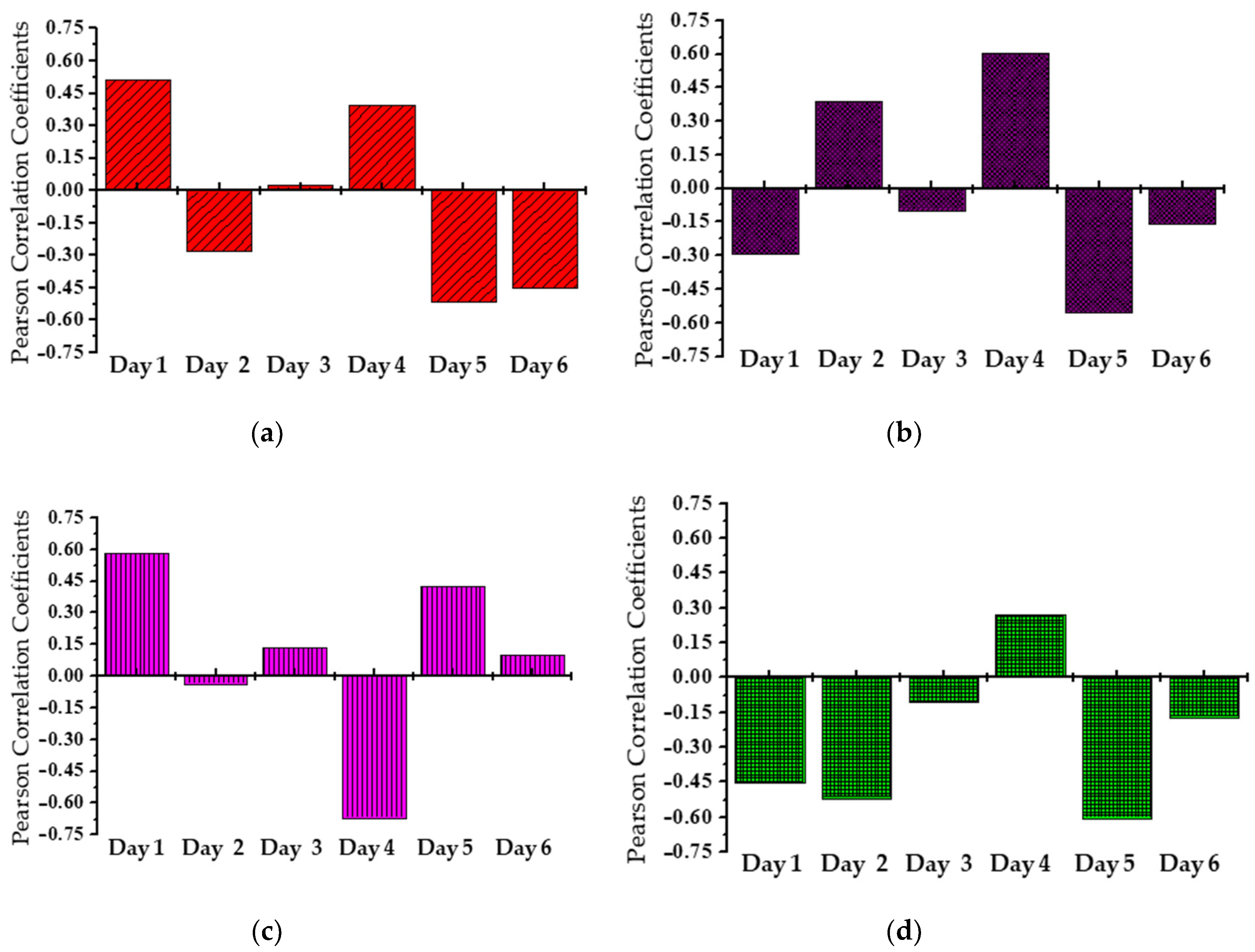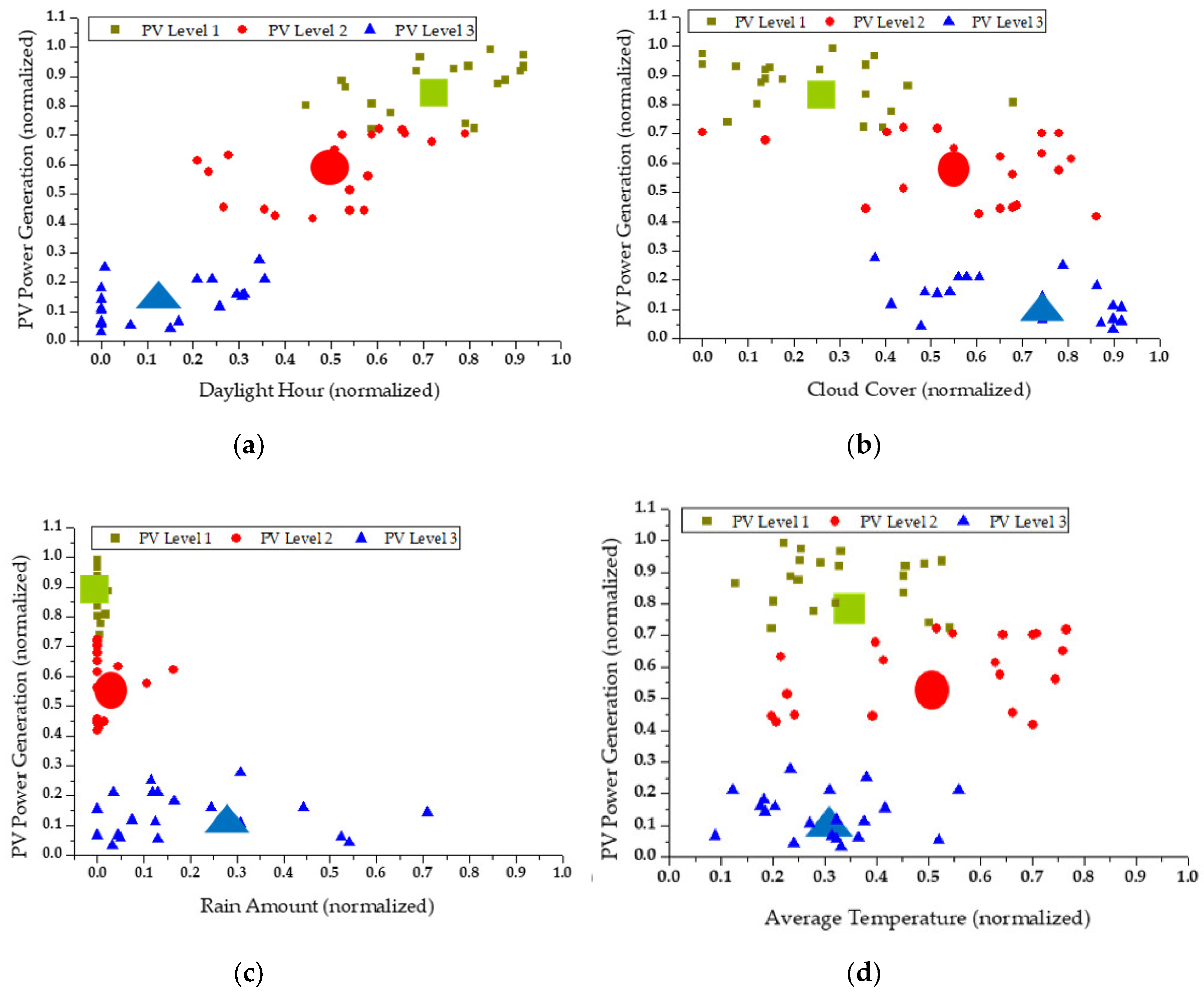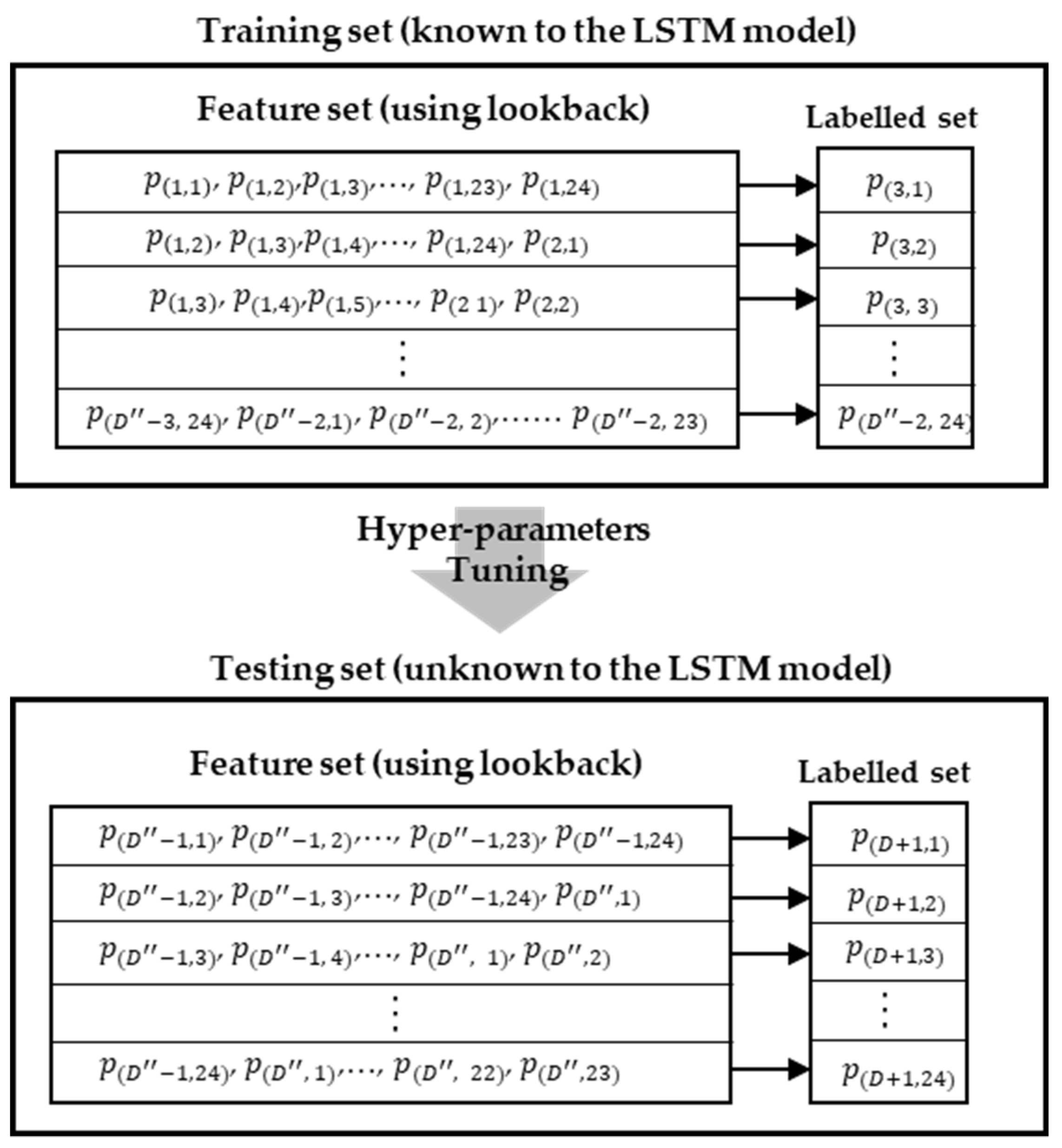Day-Ahead Forecasting for Small-Scale Photovoltaic Power Based on Similar Day Detection with Selective Weather Variables
Abstract
1. Introduction
2. Weather’s Impact on PV Power Forecasting
3. Proposed Short-Term PV Power Forecasting
3.1. Classification of Days with Historical PV Generation
3.2. Decomposition of Weather Variables
3.3. Detection of Similar Days
3.4. LSTM-Based Day-Ahead PV Power Forecasting
4. Numerical Results and Discussion
4.1. PV Data Description and Implementation
4.2. Results of Day-Ahead PV Forecasting
4.3. Comparison with Existing SDD Models
4.4. Impact of
5. Conclusions
Author Contributions
Funding
Conflicts of Interest
References
- Cohen, M.A.; Callaway, D.S. Effects of Distributed PV Generation on California’s Distribution System, Part 1: Engineering Simulations. Sol. Energy 2016, 128, 126–138. [Google Scholar] [CrossRef]
- Woyte, A.; Van Thong, V.; Belmans, R.; Nijs, J. Voltage Fluctuations on Distribution Level Introduced by Photovoltaic Systems. IEEE Trans. Energy Convers. 2006, 21, 202–209. [Google Scholar] [CrossRef]
- Das, U.K.; Tey, K.S.; Seyedmahmoudian, M.; Mekhilef, S.; Idris, M.Y.I.; Van Deventer, W.; Horan, B.; Stojcevski, A. Forecasting of Photovoltaic Power Generation and Model Optimization: A review. Renew. Sustain. Energy Rev. 2018, 81, 912–928. [Google Scholar] [CrossRef]
- Bessa, R.J.; Trindade, A.; Miranda, V. Spatial Temporal Solar Power Forecasting for Smart Grids. IEEE Trans. Ind. Inform. 2014, 3203, 232–241. [Google Scholar] [CrossRef]
- Wan, C.; Lin, J.; Song, Y.; Xu, Z.; Yang, G. Probabilistic Forecasting of Photovoltaic Generation: An Efficient Statistical Approach. IEEE Trans. Power Syst. 2017, 32, 2471–2472. [Google Scholar] [CrossRef]
- Behera, M.K.; Nayak, N. A Comparative Study on Short Term PV Power Forecasting Using Decomposition Based Optimized Extreme Learning Machine Learning Algorithm. Eng. Sci. Technol. Int. J. 2019, 23, 156–167. [Google Scholar] [CrossRef]
- Han, Y.; Wang, N.; Ma, M.; Zhou, H.; Dai, S.; Zhu, H. A PV Power Interval Forecasting Based on Seasonal Model and Nonparametric Estimation Algorithm. Sol. Energy 2019, 184, 515–526. [Google Scholar] [CrossRef]
- Alfadda, A.; Adhikari, R.; Kuzlu, M.; Rahman, S. Hour-Ahead Solar PV power forecasting Using SVR Based Approach. In Proceedings of the 2017 IEEE Power & Energy Society Innovative Smart Grid Technologies Conference (ISGT), Washington, DC, USA, 23–26 April 2017; pp. 1–5. [Google Scholar]
- Li, Z.; Rahman, S.M.; Vega, R.; Dong, B. A Hierarchical Approach Using Machine Learning Methods in Solar Photovoltaic Energy Production Forecasting. Energies 2016, 9, 55. [Google Scholar] [CrossRef]
- Ding, M.; Wang, L.; Bi, R. An ANN-Based Approach for Forecasting the Power Output of Photovoltaic System. Procedia Environ. Sci. 2011, 11, 1308–1315. [Google Scholar] [CrossRef]
- Hu, Y.; Lian, W.; Dai, S.; Zhu, H. A Seasonal Model Using Optimized Multi-Layer Neural Networks to Forecast Power Outputs of PV Plants. Energies 2018, 11, 326. [Google Scholar] [CrossRef]
- Huang, C.; Cao, L.; Peng, N.; Li, S.; Zhang, J.; Wang, L.; Luo, X.; Wang, J. Day-Ahead Forecasting of Hourly Photovoltaic Power Based on Robust Multilayer Perceptron. Sustainability 2018, 10, 4863. [Google Scholar] [CrossRef]
- Jung, Y.; Jung, J.; Kim, B.; Han, S. Long Short-Term Memory Recurrent Neural Network for Modelling Temporal Patterns in Long-Term Power Forecasting for Solar PV Facilitates: Case Study of South Korea. J. Clean. Prod. 2020, 250, 119476. [Google Scholar] [CrossRef]
- Lee, D.; Kim, K. Recurrent Neural Network-Based Hourly Prediction of Photovoltaic Power Output Using Meteorological Information. Energies 2019, 12, 215. [Google Scholar] [CrossRef]
- Zhang, Y.; Beaudin, M.; Taheri, R.; Zareipour, H.; Wood, D. Day-Ahead Power Output Forecasting for Small-Scale Solar Photovoltaic Electricity Generators. IEEE Trans. Smart Grids 2015, 6, 2253–2262. [Google Scholar] [CrossRef]
- Cheng, K.; Guo, L.M.; Zafar, M.T. Application of Clustering Analysis in the Prediction of Photovoltaic Power Generation Based on Neural Network. IOP Conf. Ser. Earth Environ. Sci. 2017, 93, 012024. [Google Scholar] [CrossRef]
- Wang, F.; Zhen, Z.; Wang, B.; Mi, Z. Comparative Study on KNN and SVM Based Weather Classification Models for Day Ahead Short-Term Solar PV Power Forecasting. Appl. Sci. 2018, 8, 28. [Google Scholar] [CrossRef]
- Nazaripouya, H.; Wang, B.; Wang, Y.; Chu, P.; Pota, H.R.; Gadh, R. Univariate Time Series Prediction of Solar Power Using a Hybrid Wavelet-ARMA-NARX Prediction Method. In Proceedings of the 2016 IEEE/PES Transmission and Distribution Conference and Exposition (T&D), Dallas, TX, USA, 3–5 May 2016; pp. 1–5. [Google Scholar]
- Lu, H.J.; Chang, G.W. A Hybrid Approach for Day-ahead Forecast of PV power Generation. Int. Fed. Autom. Control-Pap. Online 2018, 51, 634–638. [Google Scholar] [CrossRef]
- Li, P.; Zhou, K.; Lu, X.; Yang, S. A Hybrid Deep Learning Model for Short-Term PV Power Forecasting. Appl. Energy 2019, 259, 114216. [Google Scholar] [CrossRef]
- Yang, H.T.; Huang, C.M.; Huang, Y.C.; Pai, Y.S. A Weather-Based Hybrid Method for 1-day Ahead Hourly Forecasting of PV Power Output. IEEE Trans. Sustain. Energy 2014, 5, 917–926. [Google Scholar] [CrossRef]
- Dong, Z.; Yang, D.; Reindl, T.; Walsh, W.M. A Novel Hybrid Approach Based on Self-Organizing Maps, Support Vector Regression and Particle Swarm Optimization to Forecast Solar Irradiance. Energy 2015, 82, 570–577. [Google Scholar] [CrossRef]
- Massucco, S.; Mosaico, G.; Saviozzi, M.; Silvestro, F. A Hybrid Technique for Day-Ahead PV Generation Forecasting Using Clear-Sky Models or Ensemble of Artificial Neural Networks According to a Decision Tree Approach. Energies 2019, 12, 1298. [Google Scholar] [CrossRef]
- Kohonen, T. The Self-Organizing Maps. Proc. IEEE 1990, 78, 1464–1480. [Google Scholar] [CrossRef]
- Kohonen, T. Essentials of the self-organizing map. Neural Netw. 2013, 37, 52–65. [Google Scholar] [CrossRef] [PubMed]
- Chang, L.-C.; Amin, M.Z.M.; Yang, S.-N.; Chang, F.-J. Building ANN-Based Regional Multi-Step-Ahead Flood Inundation Forecast Models. Water 2018, 10, 1283. [Google Scholar] [CrossRef]
- Pattanayek, S. Pro Deep Learning with TensorFlow: A Mathematical Approach to Advanced Artificial Intelligence in Python, 1st ed.; Apress: New York, NY, USA, 2017; pp. 223–251. [Google Scholar]
- Box, G.E.P.; Jenkins, G.M.; Reinsel, G.C.; Ljung, G.M. Time Series Analysis: Forecasting and Control, 5th ed.; John Wiley & Sons: Hoboken, NJ, USA, 2015; pp. 21–176. [Google Scholar]
- Xu, R.; Chen, H.; Sun, X. Short-Term Photovoltaic Power Forecasting with Weighted Support Vector Machine. In Proceedings of the IEEE International Conference on Automation and Logistics (ICAL), Zhengzhou, China, 15–17 August 2012. [Google Scholar]
- Pedregosa, F.; Varoquax, G.; Gramfort, A. Scikit-learn: Machine Learning in Python. J. Mach. Learn. Res. 2011, 12, 2825–2830. [Google Scholar]
- Zhang, W.; Quan, H.; Srinivasan, D. An Improved Quantile Regression Neural Network for Probabilistic Load Forecasting. IEEE Trans. Smart Grid 2019, 10, 4425–4434. [Google Scholar] [CrossRef]
- Ogliari, E.; Niccolai, A.; Leva, S.; Zich, R.E. Computational Intelligence Techniques Applied to the Day Ahead PV Output Power Forecast: PHANN, SNO and Mixed. Energies 2018, 11, 1487. [Google Scholar] [CrossRef]
- Ozaki, Y.; Yano, M.; Onishi, O. Effective Hyper-Parameter Optimization using Nelder–Mead Method in Deep Learning. PSJ Trans. Comput. Vis. Appl. 2017, 9, 20–25. [Google Scholar] [CrossRef]
- Acharya, S.K.; Min, Y.M.; Lee, J. Short-term Load Forecasting for a Single Household Based on Convolution Neural Networks Using Data Augmentation. Energies 2019, 12, 3560. [Google Scholar] [CrossRef]
- Kim, J.; Cho, S.B. Evolutionary Optimization of Hyper-parameters in Deep Learning Models. In Proceedings of the 2019 IEEE Congress on Evolutionary Computation (CEC), Wellington, New Zealand, 10–13 June 2019. [Google Scholar]









| Numerical Weather Predictions (NWPs) of Weather Parameters | ||||||||
|---|---|---|---|---|---|---|---|---|
| Date | Avg. Temp (°C) | Min. Temp (°C) | Max. Temp (°C) | Wind Speed (m/s) | Rain (mm) | Humidity (%) | Day-Light Hours | Cloud Cover (max. 10) |
| 1 | −1.4 | −3.1 | −0.4 | 8.8 | 0 | 88 | 8.5 | 3.6 |
| 2 | 1 | −1.3 | 5 | 6.6 | 0.1 | 77.8 | 9.5 | 5 |
| 3 | 0.4 | 0.4 | 5.6 | 1.4 | 0 | 79.6 | 8 | 4.9 |
| 365 | 3 | 4.8 | 7.4 | 3 | 5.8 | 80.9 | 4.7 | 6.4 |
| Technical Specification | Value |
|---|---|
| Module type | Polycrystalline |
| Module capacity | 240 W |
| Total installed capacity | 1 MW |
| Installation type | Fixed |
| Module efficiency | 14.4% |
| Inverter efficiency | 96% |
| Plant location | Goheung-Gun, South Korea |
| Location coordinates | 34.61° N, 127.28° E |
| Model | Hidden Layers | Activation | Optimization | Nodes Per Layer | No. of Iterations | Testing Samples |
|---|---|---|---|---|---|---|
| SVR | N/A | N/A | SMO | N/A | default | 16-h |
| BPNN | 2 | ReLU | RMSprop | 24 | 150 | 16-h |
| LSTM | 2 | sigmoid, tanh | RMSprop | 20 | 500 | 16-h |
| Day | nMAE (%) | RMSE (kWh) | ||||||
|---|---|---|---|---|---|---|---|---|
| SVR | BPNN | LSTM | Proposed | SVR | BPNN | LSTM | Proposed | |
| 1 | 9.78 | 7.49 | 10.85 | 5.86 | 122.03 | 116.2 | 145.59 | 74.26 |
| 2 | 9.02 | 10.88 | 10.85 | 5.36 | 109.90 | 135.42 | 145.59 | 59.49 |
| 3 | 9.39 | 7.75 | 13.25 | 6.19 | 118.42 | 98.69 | 195.81 | 81.79 |
| 4 | 5.59 | 12.19 | 9.22 | 8.43 | 88.47 | 188.57 | 140.75 | 118.24 |
| 5 | 8.38 | 9.55 | 12.35 | 4.91 | 110.66 | 142.30 | 164.31 | 60.17 |
| 6 | 8.66 | 3.11 | 14.02 | 5.72 | 116.08 | 46.41 | 195.21 | 70.45 |
| 7 | 7.09 | 3.16 | 11.51 | 2.98 | 93.36 | 46.7 | 170.91 | 38.13 |
| 8 | 7.18 | 5.46 | 8.59 | 3.96 | 102.99 | 72.15 | 139.45 | 48.44 |
| 9 | 6.05 | 3.68 | 9.66 | 4.07 | 84.96 | 57.43 | 145.25 | 53.52 |
| 10 | 5.64 | 4.79 | 10.66 | 3.5 | 78.98 | 68.88 | 107.93 | 43.76 |
| 11 | 5.80 | 4.55 | 9.44 | 3.53 | 78.77 | 58.89 | 118.70 | 41.95 |
| 12 | 6.50 | 9.24 | 6.08 | 10.14 | 100.44 | 125.25 | 101.61 | 155.39 |
| 13 | 16.93 | 13.15 | 8.27 | 6.98 | 222.64 | 179.85 | 115.44 | 96.93 |
| 14 | 9.97 | 8.08 | 8.34 | 9.92 | 135.93 | 129.00 | 110.60 | 141.60 |
| Week | nMAE (%) | RMSE (kWh) | |||||||
|---|---|---|---|---|---|---|---|---|---|
| SDD-A (w/SVR) | SDD-B (w/BPNN) | SDD-B (w/LSTM) | Proposed | SDD-A (w/SVR) | SDD-B (w/BPNN) | SDD-B (w/LSTM) | Proposed | ||
| Summer (August) | 1 | 7.59 | 8.40 | 7.80 | 6.04 | 99.00 | 109.64 | 96.71 | 80.19 |
| 2 | 6.03 | 5.41 | 5.11 | 5.02 | 77.27 | 76.08 | 65.81 | 64.01 | |
| 3 | 10.99 | 6.61 | 7.57 | 6.05 | 152.48 | 99.21 | 107.85 | 83.87 | |
| 4 | 9.58 | 7.33 | 7.55 | 6.33 | 138.53 | 103.50 | 107.42 | 88.97 | |
| average | 8.55 | 6.94 | 7.01 | 5.86 | 116.82 | 97.11 | 94.45 | 79.26 | |
| Autumn (October) | 1 | 7.22 | 10.39 | 11.52 | 5.41 | 104.33 | 150.90 | 160.23 | 75.67 |
| 2 | 9.76 | 11.86 | 12.02 | 7.78 | 147.19 | 177.11 | 184.14 | 121.53 | |
| 3 | 6.66 | 7.29 | 6.31 | 5.71 | 83.52 | 110.14 | 84.82 | 82.81 | |
| 4 | 7.76 | 7.62 | 8.64 | 6.82 | 105.86 | 108.92 | 136.77 | 92.93 | |
| average | 7.85 | 9.29 | 9.62 | 6.43 | 110.23 | 136.77 | 141.49 | 93.24 | |
| Winter (December) | 1 | 9.24 | 6.40 | 6.44 | 6.16 | 145.84 | 92.04 | 87.89 | 93.22 |
| 2 | 7.23 | 9.03 | 10.76 | 7.71 | 111.25 | 142.51 | 163.56 | 110.28 | |
| 3 | 7.37 | 9.63 | 10.64 | 6.22 | 122.41 | 158.35 | 169.29 | 94.26 | |
| 4 | 8.80 | 9.67 | 9.13 | 6.30 | 125.80 | 157.36 | 155.17 | 90.64 | |
| average | 8.16 | 8.68 | 9.24 | 6.60 | 126.33 | 137.57 | 143.98 | 97.10 | |
© 2020 by the authors. Licensee MDPI, Basel, Switzerland. This article is an open access article distributed under the terms and conditions of the Creative Commons Attribution (CC BY) license (http://creativecommons.org/licenses/by/4.0/).
Share and Cite
Acharya, S.K.; Wi, Y.-M.; Lee, J. Day-Ahead Forecasting for Small-Scale Photovoltaic Power Based on Similar Day Detection with Selective Weather Variables. Electronics 2020, 9, 1117. https://doi.org/10.3390/electronics9071117
Acharya SK, Wi Y-M, Lee J. Day-Ahead Forecasting for Small-Scale Photovoltaic Power Based on Similar Day Detection with Selective Weather Variables. Electronics. 2020; 9(7):1117. https://doi.org/10.3390/electronics9071117
Chicago/Turabian StyleAcharya, Shree Krishna, Young-Min Wi, and Jaehee Lee. 2020. "Day-Ahead Forecasting for Small-Scale Photovoltaic Power Based on Similar Day Detection with Selective Weather Variables" Electronics 9, no. 7: 1117. https://doi.org/10.3390/electronics9071117
APA StyleAcharya, S. K., Wi, Y.-M., & Lee, J. (2020). Day-Ahead Forecasting for Small-Scale Photovoltaic Power Based on Similar Day Detection with Selective Weather Variables. Electronics, 9(7), 1117. https://doi.org/10.3390/electronics9071117





